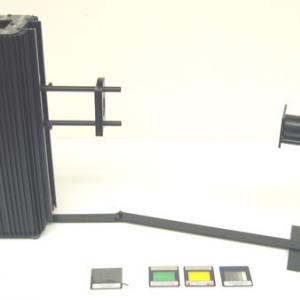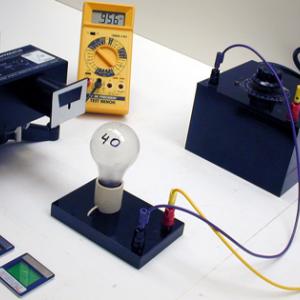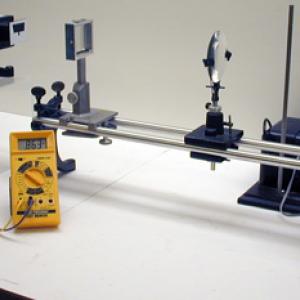College of Liberal Arts & Sciences
7A10.32 - Photoelectric Effect Stopping Potential
Connect the photoelectric head to the voltmeter and place the light bulb a few inches in front of the head input slit. Turn on the light bulb to a desired intensity and observe the stopping voltage. Insert the filters and again observe the stopping voltage for each filter. The stopping voltage should be higher toward the blue end of the spectrum. The neutral density filter may be used to show that the stopping voltage does not depend upon intensity.
- Gonzalo Fuster, Roberto Rojas, "Gravitational Analogies for the Stopping Voltage and the Work Function in the Photoelectric Effect", TPT, Vol. 59, #3, March 2021, p. 196.
- Conrad Schiff, "Photoelectric Effects", TPT, Vol. 58, #3, Mar. 2020, p. 147.
- Josu Martinez-Perdiguero, "On a Common Mistake in the Description of the Photoelectric Effect", TPT, Vol. 57, #8, Nov. 2019, p. 536.
- Adolf Cortel, "Tweaking 'Simple Photoelectric Effect' Demo", TPT, Vol. 44, #7, Oct. 2006, p. 406.
- Jeffrey Goldader, "Simple Photoelectric Effect", TPT, Vol. 44, #5, May 2006, p. 310.
- Wayne P. Garver, "The Photoelectric Effect Using LEDs as Light Sources", TPT, Vol. 44, #5, May 2006, p. 272.
- Howard Fisher, "Planck's Constant Experiment", TPT, Vol. 23, #6, Sept. 1985, p. 334.
- Evan S. Snyder, "A Correction to the Pholoelectric Current in the Planck's Constant Experiment", TPT, Vol. 23, #2, Feb. 1985, p. 98.
- Hanna Goldring, "Correction Corrected", TPT, Vol. 17, #7, Oct. 1979, p. 416.
- Herbert H. Gottlieb, "Photoelectric Effect Using a Transistorized Electrometer", TPT, Vol. 3, #8, Nov. 1965, p. 380.
- J. Dean Barnett and Harold T. Stokes, "Improved Student Laboratory on the Measurement of Planck's Constant using the Photoelectric Effect", AJP, Vol. 56, #1, Jan. 1988, p. 86.
- Richard L. Bobst and Edwin A. Karlow, "A Direct Potential Measurement in the Photoelectric Effect Experiment", AJP, Vol. 53, #9, Sep. 1985, p. 911.
- R. A. Powell, "Photoelectric Effect: Back to Basics", AJP, Vol. 46, #10, Oct. 1978, p. 1046.
- Donald W. Boys, Mary E. Cox, and William Mykolajenko, "Photoelectric Effect Revisited (or an Inexpensive Device to Determine h/e)", AJP, Vol. 46, #2, Feb. 1978, p. 133.
- J. Rudnick, D. S. Tannhauser, "Concerning a Widespread Error in the Description of the Photoelectric Effect", AJP, Vol. 44, #8, Aug. 1976, p. 796.
- Thomas R. Carver and John O. Crawford, "Useful Lecture Demonstration of Photoelectric Wavelength Threshold", AJP, Vol. 43, #4, Apr. 1975, p. 370.
- Harry H. Hall, "A New Amplifier for the Photoelectric Effect and Planck's Constant Experiment", AJP, Vol. 39, #12, Dec. 1971, p. 1542.
- Robert E. Ellefson, "An Inexpensive Photoelectric Effect Apparatus", AJP, Vol. 38, #6, June 1970, p. 767.
- G. D. Freier and F. J. Anderson, "MPb-1. Photoelectric Effect", A Demonstration Handbook for Physics.
- T. D. Rossing and C. J. Chiaverina, "2.9. The Particle Nature of Light: Observing Photons", Light Science, Physics and Visual Arts, p. 34 - 35.
- W. Bolton, "35. Photons and Frequency", Book 2 - Waves and Particles, Physics Experiments and Projects, 1968, p. 57 - 58.
Disclaimer: These demonstrations are provided only for illustrative use by persons affiliated with The University of Iowa and only under the direction of a trained instructor or physicist. The University of Iowa is not responsible for demonstrations performed by those using their own equipment or who choose to use this reference material for their own purpose. The demonstrations included here are within the public domain and can be found in materials contained in libraries, bookstores, and through electronic sources. Performing all or any portion of any of these demonstrations, with or without revisions not depicted here entails inherent risks. These risks include, without limitation, bodily injury (and possibly death), including risks to health that may be temporary or permanent and that may exacerbate a pre-existing medical condition; and property loss or damage. Anyone performing any part of these demonstrations, even with revisions, knowingly and voluntarily assumes all risks associated with them.


